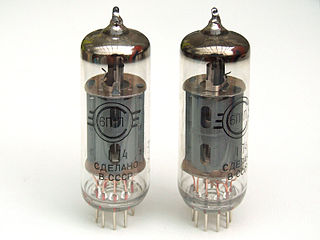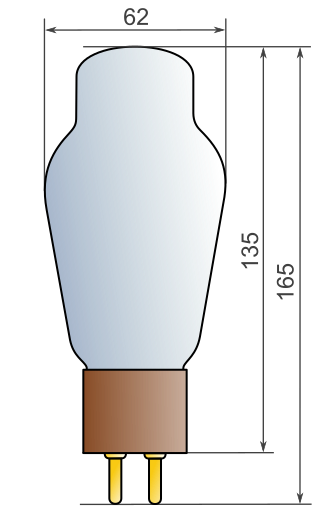
Compactrons are a type of vacuum tube, which contain multiple electrode structures packed into a single enclosure. They were designed to compete with early transistor electronics and were used in televisions, radios, and similar roles.
Pro Electron or EECA is the European type designation and registration system for active components.

12AX7 is a miniature dual-triode 6AV6 vacuum tube with high voltage gain. Developed around 1946 by RCA engineers in Camden, New Jersey, under developmental number A-4522, it was released for public sale under the 12AX7 identifier on September 15, 1947.

6SN7 is a dual triode vacuum tube with an eight-pin octal base. It provides a medium gain. The 6SN7 is basically two 6J5 triodes in one envelope.

KT66 is the designator for a beam power tube introduced by Marconi-Osram Valve Co. Ltd. (M-OV) of Britain in 1937 and marketed for application as a power amplifier for audio frequencies and driver for radio frequencies. The KT66 is a beam tetrode that utilizes partially collimated electron beams to form a low potential space charge region between the anode and screen grid to return anode secondary emission electrons to the anode and offers significant performance improvements over comparable power pentodes. In the 21st century, the KT66 is manufactured and used in some high fidelity audio amplifiers and musical instrument amplifiers.

A beam tetrode, sometimes called a beam power tube, is a type of vacuum tube or thermionic valve that has two grids and forms the electron stream from the cathode into multiple partially collimated beams to produce a low potential space charge region between the anode and screen grid to return anode secondary emission electrons to the anode when the anode potential is less than that of the screen grid. Beam tetrodes are usually used for power amplification, from audio frequency to radio frequency. The beam tetrode produces greater output power than a triode or pentode with the same anode supply voltage. The first beam tetrode marketed was the Marconi N40, introduced in 1935. Beam tetrodes manufactured and used in the 21st century include the 4CX250B, KT66 and variants of the 6L6.

The 6V6 is a beam-power tetrode vacuum tube. The first of this family of tubes to be introduced was the 6V6G by Ken-Rad Tube & Lamp Corporation in late 1936, with the availability by December of both Ken-Rad and Raytheon 6V6G tubes announced. It is still in use in audio applications, especially electric guitar amplifiers.

A pentode is an electronic device having five electrodes. The term most commonly applies to a three-grid amplifying vacuum tube or thermionic valve that was invented by Gilles Holst and Bernhard D.H. Tellegen in 1926. The pentode was developed from the screen-grid tube or shield-grid tube by the addition of a grid between the screen grid and the plate. The screen-grid tube was limited in performance as an amplifier due to secondary emission of electrons from the plate. The additional grid is called the suppressor grid. The suppressor grid is usually operated at or near the potential of the cathode and prevents secondary emission electrons from the plate from reaching the screen grid. The addition of the suppressor grid permits much greater output signal amplitude to be obtained from the plate of the pentode in amplifier operation than from the plate of the screen-grid tube at the same plate supply voltage. Pentodes were widely manufactured and used in electronic equipment until the 1960s to 1970s, during which time transistors replaced tubes in new designs. During the first quarter of the 21st century, a few pentode tubes have been in production for high power radio frequency applications, musical instrument amplifiers, home audio and niche markets.

The EL34 is a thermionic vacuum tube of the power pentode type. The EL34 was introduced in 1955 by Mullard, who were owned by Philips. The EL34 has an octal base and is found mainly in the final output stages of audio amplification circuits; it was also designed to be suitable as a series regulator by virtue of its high permissible voltage between heater and cathode and other parameters. The American RETMA tube designation number for this tube is 6CA7. The USSR analog was 6P27S.

A single-ended triode (SET) is a vacuum tube electronic amplifier that uses a single triode to produce an output, in contrast to a push-pull amplifier which uses a pair of devices with antiphase inputs to generate an output with the wanted signals added and the distortion components subtracted. Single-ended amplifiers normally operate in Class A; push-pull amplifiers can also operate in Classes AB or B without excessive net distortion, due to cancellation.
The Radio Electronics Television Manufacturers' Association was formed in 1953, as a result of mergers with other trade standards organisations, such as the RMA. It was principally responsible for the standardised nomenclature for American vacuum tubes - however the standard itself had already been in use for a long time before 1953; for example, the 6L6 was introduced in July 1936.
In Europe, the principal method of numbering vacuum tubes was the nomenclature used by the Philips company and its subsidiaries Mullard in the UK, Valvo(de, it) in Germany, Radiotechnique (Miniwatt-Dario brand) in France, and Amperex in the United States, from 1934 on. Adhering manufacturers include AEG (de), CdL (1921, French Mazda brand), CIFTE (fr, Mazda-Belvu brand), EdiSwan (British Mazda brand), Lorenz (de), MBLE(fr, nl), RCA (us), RFT(de, sv) (de), Siemens (de), Telefunken (de), Tesla (cz), Toshiba (ja), Tungsram (hu), and Unitra. This system allocated meaningful codes to tubes based on their function and became the starting point for the Pro Electron naming scheme for active devices.
Vacuum tubes produced in the former Soviet Union and in present-day Russia carry their own unique designations. Some confusion has been created in "translating" these designations, as they use Cyrillic rather than Latin characters.

The 6P1P is a Soviet-made miniature 9-pin beam tetrode vacuum tube with ratings similar to the 6AQ5, EL90 and the 6V6. Because of a different pinout than an 6AQ5/EL90, it cannot be used as a plug-in replacement for these types; however, it will work in the same circuit with component values unchanged. Its maximum plate/screen voltage and dissipation ratings are actually slightly higher than a 6AQ5. A ruggedized/extended ratings version of the tube is designated 6P1P-EV, roughly equivalent to the 6AQ5W. A Chinese-manufactured version of the tube also exists, labeled 6P1.
A valve audio amplifier (UK) or vacuum tube audio amplifier (US) is a valve amplifier used for sound reinforcement, sound recording and reproduction.
The 6AQ5 is a miniature 7-pin (B7G) audio power output pentode vacuum tube with ratings virtually identical to the 6V6 at 250 V. It was commonly used as an output audio amplifier in tube TVs and radios. It was also used in transmitter circuits. There are versions of this tube with extended ratings for industrial application which are designated as 6AQ5A, and 6AQ5W/6005 or 6005W.
The KT88 is a beam tetrode/kinkless tetrode vacuum tube for audio amplification.

In electronics, the 300B is a directly-heated power triode vacuum tube with a four-pin base, introduced in 1938 by Western Electric to amplify telephone signals. It measures 6.4 in (16 cm) high and 2.4 in (6.1 cm) wide, and the anode can dissipate 40 watts thermal. In the 1980s it began to be used increasingly by audiophiles in home audio equipment. The 300B has good linearity, low noise and good reliability; it is often used in single-ended triode (SET) audio amplifiers of about eight watts output. A push-pull pair can output 20 watts.

The EF86 is a high transconductance sharp cutoff pentode vacuum tube with Noval (B9A) base for audio-frequency applications.

The 12BV7, 12BY7, 12BY7A, and equivalents were a class of medium-low gain, pentode vacuum tube amplifiers using the Noval socket configuration. Although originally marketed as pentode tubes for use in early television receivers, they found additional uses in audio and radiotelephone equipment. The series shares the EIA 9BF pinout with a number of other miniature pentode tubes of the era.













